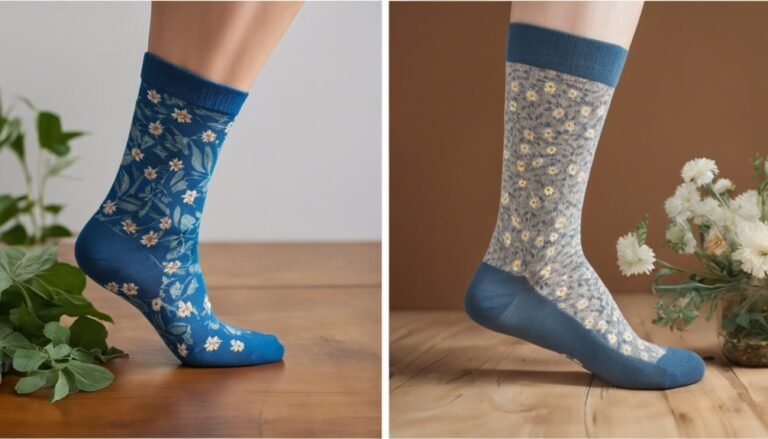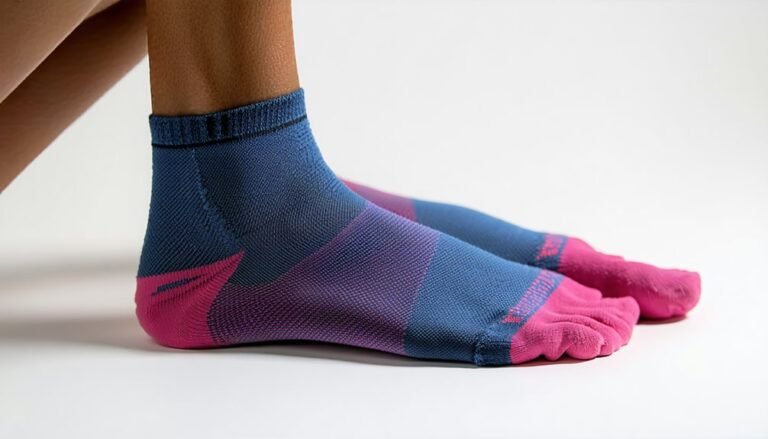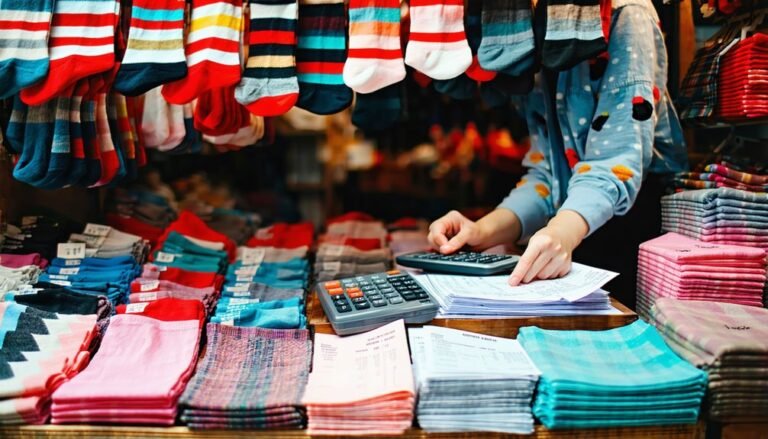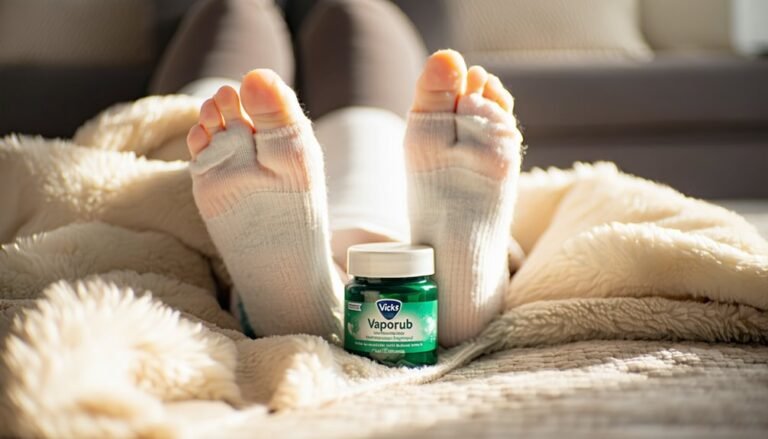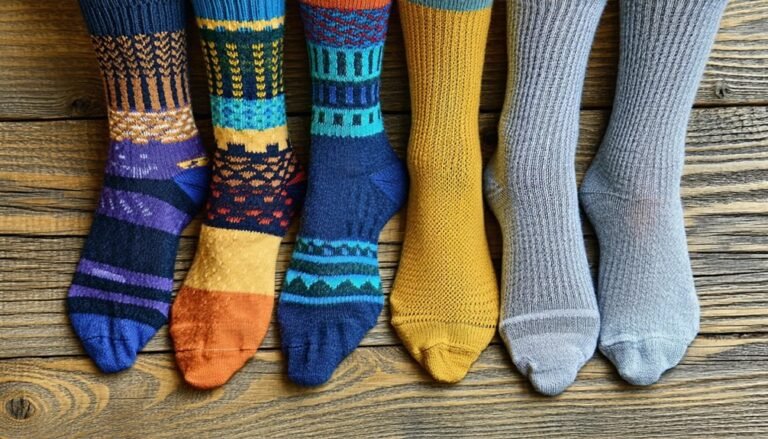Can You Recycle Socks?
Yes, you can recycle socks, contributing to a sustainable future by using recycling programs offered by brands like Smartwool and Darn Tough or participating in H&M's Garment Collecting initiative. While recycling challenges arise due to mixed fiber compositions, innovative solutions like biodegradable materials and advanced technologies are emerging. Also, explore local recycling options through municipal programs or events. Discover how these actions reduce textile waste, support a circular economy, and leave a positive environmental impact.
Understanding Textile Waste and Its Impact

When considering the vast scope of textile waste, it is crucial to understand its significant environmental impact. Textile waste contributes to landfills' growth, releasing harmful chemicals and greenhouse gases. With over 92 million tons discarded annually, you must focus on textile sustainability. Shifting to a circular economy can drastically reduce waste by promoting reuse and recycling. This system keeps materials in use longer, ensuring that resources are continually cycled back into production rather than discarded. By adopting sustainable practices, you help mitigate environmental damage, conserve resources, and enhance safety for future generations. Prioritize purchasing durable textiles, supporting brands that champion sustainability, and donating or repurposing old textiles. These actions contribute to a more sustainable future and a safer planet.
The Basics of Textile Recycling
Reducing textile waste is fundamental to achieving a sustainable future, and understanding the basics of textile recycling is an essential step in this process. Different textile types, like cotton, polyester, and wool, require specific recycling processes to guarantee safety and efficiency. You should be aware that recycling textiles involves sorting, shredding, and sometimes chemical treatments to produce reusable fibers.
| Textile Type | Recycling Process |
|---|---|
| Cotton | Mechanical shredding |
| Polyester | Chemical recycling |
| Wool | Mechanical carding |
| Nylon | Depolymerization |
| Blends | Mixed processes |
It's important to know that effective recycling reduces landfill waste, conserves resources, and minimizes environmental impact. By understanding these processes, you contribute to a safer, more sustainable world. Always check for local textile recycling programs to guarantee proper disposal.
Challenges in Recycling Socks
When you consider recycling socks, the material composition complexity presents a significant challenge, as socks often contain blends of cotton, polyester, and spandex that are difficult to separate. Additionally, the limited recycling infrastructure for textiles means that specialized facilities capable of handling such materials are scarce. To effectively address these obstacles, investing in advanced sorting technologies and expanding textile recycling initiatives could be essential steps forward.
Material Composition Complexity
Although recycling seems straightforward, the material composition of socks presents substantial challenges. Socks often consist of mixed material types like cotton, polyester, and elastane. These blends complicate recycling processes because each material requires distinct handling. To effectively recycle socks, you need to separate these materials, which is both labor-intensive and costly. Here's why it's tough:
- Material Types: Socks often include a mix that doesn't easily break down.
- Recycling Processes: Each type of fiber demands a specific recycling method, making unified processing difficult.
- Contamination Risk: Different materials can contaminate batches, reducing overall recycling efficiency.
Limited Recycling Infrastructure
The complexities of material composition are just part of the recycling puzzle when it comes to socks. Limited recycling infrastructure further complicates matters. Many municipal systems lack the facilities to handle textiles, including socks, due to their mixed fibers. This gap means your socks often end up in landfills, contributing to environmental harm. However, adopting sustainable practices can mitigate this issue. Consider advocating for community initiatives that support textile recycling. Programs like local collection drives and partnerships with specialized recycling firms can create a safer, more sustainable solution. By working together, you can encourage the development of a more robust infrastructure, ensuring socks are recycled effectively rather than discarded irresponsibly. Your involvement can make a significant difference in promoting a cleaner, safer environment.
Innovative Solutions for Sock Recycling
Even as traditional recycling methods struggle to accommodate them, innovative solutions are emerging to tackle the challenge of sock recycling. By focusing on sustainable textiles and creative repurposing, you can contribute to a safer, eco-friendly future. Here's how:
- Sustainable Textiles: Researchers are developing biodegradable materials for socks, reducing reliance on harmful synthetics. These materials break down safely, minimizing environmental impact.
- Creative Repurposing: Transform old socks into household items like cleaning rags or plant ties. This approach reduces waste and promotes resourcefulness.
- Fiber Recovery: Advanced technology extracts fibers from worn-out socks, repurposing them into new products like insulation or stuffing. This method guarantees that less material ends up in landfills.
Embrace these strategies to guarantee a safer, greener planet.
Brands and Programs Supporting Sock Recycling

You'll find that several brands are leading the charge in sock recycling, with major players like Smartwool and Darn Tough offering take-back programs to repurpose your worn-out socks. Companies like Terracycle also provide innovative recycling solutions, turning old textiles into new products. By participating in these programs, you're not only reducing landfill waste but also supporting a circular economy.
Major Sock Recycling Brands
When it comes to reducing textile waste, several major brands are stepping up with innovative sock recycling programs. These initiatives not only promote sustainable fashion but also guarantee safe and environmentally-friendly processes. If you're considering sock donations or recycling, here are three brands to keep an eye on:
- Smartwool: Known for their "Second Cut Program," they encourage customers to send back old socks, which are then transformed into new products.
- Darn Tough: This brand offers a lifetime guarantee, turning worn-out socks into valuable resources instead of landfill waste.
- H&M: Their Garment Collecting initiative accepts socks and other textiles, promoting recycling and repurposing efforts globally.
Innovative Recycling Programs
Although recycling socks may not be the first thing that comes to mind when thinking about sustainable practices, innovative recycling programs are making it easier for everyone to contribute to reducing textile waste. Brands are increasingly embracing sustainable materials and fostering a circular economy by implementing sock recycling initiatives. For example, some companies offer take-back programs where you can drop off old socks to be repurposed or recycled into new products. These initiatives guarantee that textiles are not wasted, reducing landfill contributions and promoting environmental safety. By participating in these programs, you're not only decluttering your home but also actively supporting global efforts to create a safer, more sustainable world. Look for local or online programs to participate in and make a tangible difference.
Steps to Prepare Your Socks for Recycling

Before tossing your old socks into a recycling bin, it's crucial to prepare them properly to guarantee they're processed efficiently. Taking these steps guarantees you're contributing to textile sustainability:
- Clean Your Socks: Wash them thoroughly to remove any dirt or odors. Clean socks are safer for recycling centers to handle and process.
- Check for Donations: Not all socks are recyclable. Consider sock donation for those in good condition. Many charities accept gently worn socks, supporting those in need and reducing waste.
- Sort by Material: Different materials require different recycling methods. Group socks by fabric type (e.g., cotton, wool) for streamlined processing. This helps recycling facilities manage them safely and effectively.
Alternatives to Recycling: Upcycling and Reuse Ideas
If you're looking for ways to repurpose your old socks beyond recycling, upcycling and reusing offer creative and practical solutions. Turning socks into upcycled crafts like sock puppets is a fun, safe activity for all ages. With just a few simple materials like buttons and thread, you can create entertaining puppets that enhance storytelling and imaginative play. For those concerned about safety, verify that small parts are securely attached to prevent any choking hazards. Additionally, socks can be used as protective covers for fragile items during storage or moving. By using old socks as cleaning rags, you reduce waste and minimize exposure to harsh chemicals found in some commercial cleaning products. Embrace these eco-friendly strategies to extend the life of your socks.
How to Find Local Sock Recycling Options
While upcycling and reusing are excellent ways to extend the life of your old socks, sometimes recycling is the most suitable option to guarantee they're processed sustainably. To find sock recycling options near you, consider these steps:
- Local Initiatives: Check with your city's waste management department for any textile recycling programs. Many municipalities have partnerships with recycling organizations.
- Community Programs: Explore local community centers and libraries. They often host recycling events or have information on ongoing programs specifically for textiles.
- Retailer Partnerships: Some clothing retailers offer take-back programs. Brands often collaborate with recycling companies to accept old socks and transform them into new products.
Prioritize your safety by verifying the recycling centers follow proper protocols and maintain environmental standards. This ensures your socks are handled responsibly.
Frequently Asked Questions
Can Socks Be Recycled With Regular Clothing Items?
You can't recycle socks with regular clothing items due to material differences. Instead, consider the sock recycling process or clothing donation alternatives. These options guarantee safe disposal and promote sustainability, protecting the environment for future generations.
Are There Any Eco-Friendly Sock Materials to Consider?
When selecting socks, you should consider sustainable fibers like organic cotton. They're not only eco-friendly but also safe for you and the planet. Choosing such materials helps reduce environmental impact while ensuring your comfort and well-being.
How Often Should I Recycle My Socks?
Imagine your socks as loyal companions. Their lifespan often depends on wear, but generally, recycling them every 6-12 months guarantees safety and sustainability. Regularly evaluating them can help maintain both comfort and environmental responsibility.
Can Socks Be Composted Instead of Recycled?
You're wondering if socks can be composted. If they're made of biodegradable materials like cotton or wool, they can be. Guarantee proper composting methods are followed to avoid pests and maintain safety in your compost pile.
Do Sock Recycling Programs Accept Mismatched Pairs?
Imagine a patchwork quilt; mismatched socks find their place in recycling programs. They accept these odd pairs, offering recycling benefits like reducing landfill waste. Ensuring a safe environment is part of the program's fabric of solutions.


